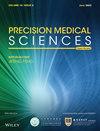Patterns of distant metastases in patients with triple‐negative breast cancer—A population‐based study
IF 0.6
Q4 MEDICINE, RESEARCH & EXPERIMENTAL
引用次数: 0
Abstract
Abstract This study provided systematic insights into the patterns of triple‐negative breast cancer (TNBC) distant metastases (DM) and investigated the related elements for the prognosis prediction of TNBC patients based on a large sample. We reviewed eligible patients with TNBC from the SEER database between 2010 and 2015. We also analyzed differences in baseline characteristics among patients with diverse modes of metastasis. Meanwhile, we calculated proportional mortality ratio and expression of proportional trends in different patients. Subsequently, KM analysis was employed to investigate the survival outcomes. Finally, the predictive and prognostic factors of DM were identified. In this study, we included 24 822 TNBC patients, including 1026 DM patients and 23 796 non‐DM patients. At the time of initial diagnosis, 4.1% of patients had DM, and 36.9% had multiple metastases. According to the study, the most common sites of metastasis in DM patients were bone (251 cases) and lung (244 cases), while the least common organ of metastasis was brain (37 cases). Age, grade, T, N, and marital status were deemed as risk elements of DM. T stage, insurance status, marital status, surgery treatment, chemotherapy, number of metastatic sites, and metastatic sites also significantly affected the diagnosis of DM. Our study showed that the most common site of metastasis in TNBC patients with DM was bone and the least common site was brain. Different modes of metastasis have different survival and prognostic characteristics. Thus, our research may have important implications for the clinical practice of TNBC patients in the future.三阴性乳腺癌患者的远处转移模式——基于人群的研究
本研究在大样本的基础上,对三阴性乳腺癌(TNBC)远处转移(DM)的模式进行了系统的了解,并探讨了TNBC患者预后预测的相关因素。我们回顾了2010年至2015年间SEER数据库中符合条件的TNBC患者。我们还分析了不同转移方式患者的基线特征差异。同时计算不同患者的比例死亡率及比例趋势表达。随后,采用KM分析调查生存结局。最后,确定糖尿病的预测和预后因素。在这项研究中,我们纳入了24822例TNBC患者,其中包括1026例糖尿病患者和23796例非糖尿病患者。初诊时,有4.1%的患者患有糖尿病,36.9%的患者有多发转移。研究发现,DM患者最常见的转移部位是骨(251例)和肺(244例),而最不常见的转移器官是脑(37例)。年龄、分级、T、N、婚姻状况被认为是DM的危险因素,T分期、保险状况、婚姻状况、手术治疗、化疗、转移部位数量、转移部位也对DM的诊断有显著影响。我们的研究显示TNBC合并DM患者转移部位最常见的是骨,最不常见的是脑。不同的转移方式有不同的生存和预后特征。因此,我们的研究可能对未来TNBC患者的临床实践具有重要意义。
本文章由计算机程序翻译,如有差异,请以英文原文为准。
求助全文
约1分钟内获得全文
求助全文

 求助内容:
求助内容: 应助结果提醒方式:
应助结果提醒方式:


